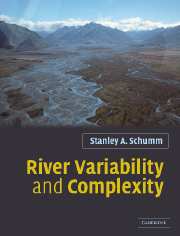Book contents
- Frontmatter
- Contents
- Preface
- Acknowledgments
- Part I Background
- Part II Upstream controls
- Chapter 4 History
- Chapter 5 Tectonics and relief
- Chapter 6 Lithology
- Chapter 7 Climate: hydrology
- Chapter 8 Humans
- Part III Fixed local controls
- Part IV Variable local controls
- Part V Downstream controls
- Part VI Rivers and humans
- References
- Index
Chapter 8 - Humans
Published online by Cambridge University Press: 05 June 2012
- Frontmatter
- Contents
- Preface
- Acknowledgments
- Part I Background
- Part II Upstream controls
- Chapter 4 History
- Chapter 5 Tectonics and relief
- Chapter 6 Lithology
- Chapter 7 Climate: hydrology
- Chapter 8 Humans
- Part III Fixed local controls
- Part IV Variable local controls
- Part V Downstream controls
- Part VI Rivers and humans
- References
- Index
Summary
According to Dynesius and Nilsson (1994), 77 percent of the 139 largest river systems in North America (north of Mexico), in Europe and in the republics of the former Soviet Union are affected by dams, reservoir operation, interbasin diversions, and irrigation. It is obvious that humans have impacted rivers since the beginning of civilization in the valleys of the Yellow, Indus, Tigris-Euphrates, Ganges, and Nile rivers (Figure 1.2). In fact, the earliest dam was constructed on a tributary of the Nile south of Cairo about 5000 years ago (Schnitter, 1994).
Graf (2001) calculates that 79 percent of American rivers are affected by humans (Table 8.1), and he developed a scale of naturalness that is illustrated by five American rivers (Table 8.2). Much of the fragmentation of rivers in the United States is due to 80 000 dams that have been constructed on these rivers.
Wohl (2001) states that when she moved to Colorado in 1989 she “was impressed by the sparkling water of the mountain rivers, … and assumed that these were natural fully functional rivers.” However, when she “began to read historical accounts of the Colorado Front range and to examine the streams more closely” she “realized how dramatically they had been altered.” She began to “think of them as virtual rivers, which had the appearance of natural rivers but had lost much of a natural river's ecosystem functions.
- Type
- Chapter
- Information
- River Variability and Complexity , pp. 79 - 94Publisher: Cambridge University PressPrint publication year: 2005



